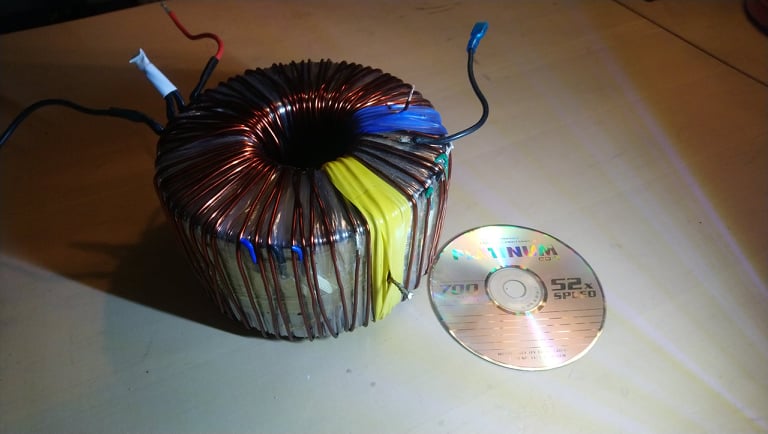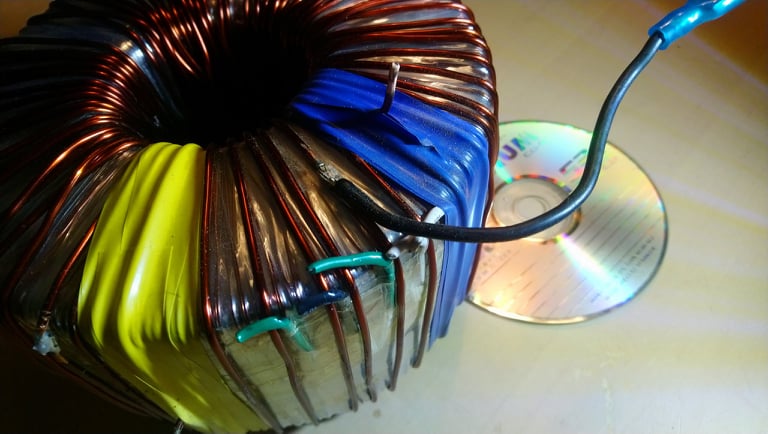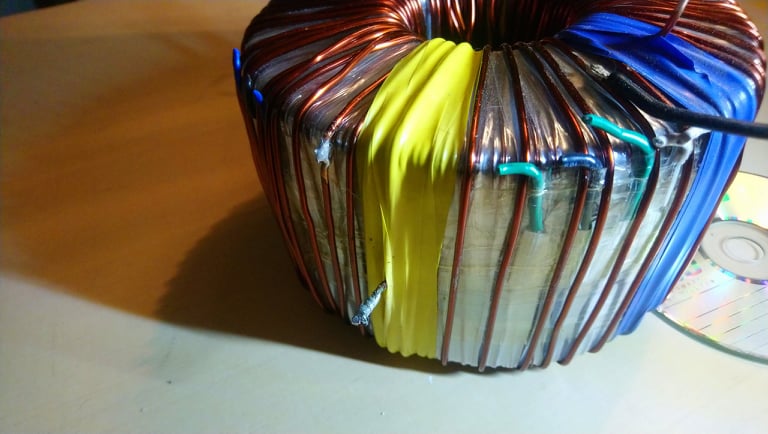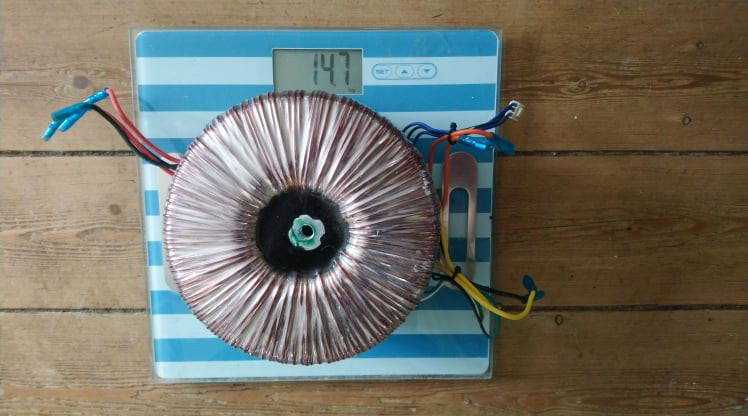The windings that were there as original were not tight, (picture) and the new winding I want to put on comes closer to the core even though there is plastic splicing on the conductor


Use lacquered, and just wind it tight , no one uses plastic insulated wire on the actual winding.
Do you know the original turns ratio ?
And what voltage/current ratio you want out of this new configuration?
Do you know the original turns ratio ?
And what voltage/current ratio you want out of this new configuration?
I know you usually don´t use plastic insulated copper wire, but it will be easier and much cheaper and that is something I already have.
It is outer and final winding so it is limited how hot it will get.
The question was whether it could be done at all.
The voltage should be 2 x 42.5 Vac and the current around 12-15 amps
It is outer and final winding so it is limited how hot it will get.
The question was whether it could be done at all.
The voltage should be 2 x 42.5 Vac and the current around 12-15 amps
I've heard of people rewinding a microwave transformer secondary with stranded flex to use it as a spot welding transformer, I doubt however that such is recommend practice...
I'm tight with money, but even I would just buy the right transformer, if I couldn't salvage one out of something else.
I'm tight with money, but even I would just buy the right transformer, if I couldn't salvage one out of something else.
Laquered (enameled) copper wire is the best choice to build transformer windings because the enamel does not soften and lose insulating proprierties and/or start to vibrate at comparatively low temperature, as standard PVC coated wire does. It also does not waste space.
On that size core you’ll need about 106 turns, with that current you need #10. You will never be able to get that many on a shuttle and make it fit with regular insulated wire. Might get away with #11, but that’s only available in magnet wire. And if plastic insulated, still wouldn’t fit. Adding a few extra turns or low current tertiary windings is practical with regular wire, but building a whole trafo is not. PVC insulation should not be used - higher temp stuff like THHN is ok, again, if you don’t need to fill the whole thing with it.
When I was a kid I used to wind my own E + I transformers , usually very small wattage ones, I was doing it because I had no money and because I was curious to see the results . But I learn that I personally could never wind those transformers like it is done in factories .
Don’t waste your time !
Don’t waste your time !
I finished it and used the same copper wire that I took off. I had to solder them together as it was not in one piece, but the solder is nowhere near anything other than lacquered wire.
Both windings measure 42.40 Vac



Both windings measure 42.40 Vac



The transformer will come in a metal box that is a bit larger and then comes P.U. foam in it so that it becomes as quiet as possible
That's one lump of a transformer, how much does it weigh?
I understand now why you wanted to reuse it.
I understand now why you wanted to reuse it.
Not bad as first try. It will work if you don't need the full 3800VA of the original configuration and the load does not draw more current than the recovered wire section will allow (I assume you already checked this). If you want to further improve the work:
- use Kapton tape instead of standard PVC electrical tabe. Kapton tape will not become soft and sticky when the transformer core will become warm.
- try to space the winding evenly around the toroid. This will maximise the iron core utilization. Avoid overlapping coils.
- use a spaghetti tubing on the lead out wires and on the soldering.
- P.U. foam may become smelly and loose when the core will rise the temperature. It may be OK only if you plan to derate the power drastically, let's say 50%. Check the product label or make a test before application. There are special potting compounds for transformers on the market.
- use Kapton tape instead of standard PVC electrical tabe. Kapton tape will not become soft and sticky when the transformer core will become warm.
- try to space the winding evenly around the toroid. This will maximise the iron core utilization. Avoid overlapping coils.
- use a spaghetti tubing on the lead out wires and on the soldering.
- P.U. foam may become smelly and loose when the core will rise the temperature. It may be OK only if you plan to derate the power drastically, let's say 50%. Check the product label or make a test before application. There are special potting compounds for transformers on the market.
I have used the same wire that was sitting there originally.
The transformer will be used for 3 class D amplifier boards, each of which is approximately 6-700 (real) watts (4 ohm). And since it's music and not continuous power, I'm not getting near the 3800 watt limit. However, due to the thickness of the wire, there is a low secondary impedance.
But thanks 😉
The transformer will be used for 3 class D amplifier boards, each of which is approximately 6-700 (real) watts (4 ohm). And since it's music and not continuous power, I'm not getting near the 3800 watt limit. However, due to the thickness of the wire, there is a low secondary impedance.
But thanks 😉
I don’t think it’s 3800 VA. That’s the same weight as the 1500 VA Anteks. You *can* pull a full 1500 watts off of them, drawing over 2kVA. But not 3.8. How many volts per turn did you end up with? 1.5kVA is typically 1 turn per volt, 1kVA is about 0.8.
You do need to tape the windings. The Mylar non-adhesive stuff is nice - but EXPENSIVE. Kapton is more readily available from the usual distributors. Don’t use plastic spaghetti tubing to cover the solder joints and provide strain relief - get the non-expanding polyester braided tubing from Alpha Wire. That’s designed for applications like this. Many trafo manufacturers use it. 25 foot roll will be about 30 bucks, but will make many transformers.
You do need to tape the windings. The Mylar non-adhesive stuff is nice - but EXPENSIVE. Kapton is more readily available from the usual distributors. Don’t use plastic spaghetti tubing to cover the solder joints and provide strain relief - get the non-expanding polyester braided tubing from Alpha Wire. That’s designed for applications like this. Many trafo manufacturers use it. 25 foot roll will be about 30 bucks, but will make many transformers.
Antek transformers are for sure bigger and heavier than other good toroidal transformer brands .
For example , I really like the vpm series from triadmagnetics https://catalog.triadmagnetics.com/Asset/VPM-Series.pdf
VPM48-2080 - 100Va 2x24V weights 1,2kg aprox 2.64 pounds
or
Hammond 1182 Series - 1182M22 - Hammond Mfg.
120VA 2x22v weight 3 pounds
vs
AS-1224 - 100VA 2x24V TRANSFORMER weight aprox 4 POUNDS
For example , I really like the vpm series from triadmagnetics https://catalog.triadmagnetics.com/Asset/VPM-Series.pdf
VPM48-2080 - 100Va 2x24V weights 1,2kg aprox 2.64 pounds
or
Hammond 1182 Series - 1182M22 - Hammond Mfg.
120VA 2x22v weight 3 pounds
vs
AS-1224 - 100VA 2x24V TRANSFORMER weight aprox 4 POUNDS
It's the transformer from this amplifier.
Next-proaudio MA3800
When I wound the wire on again, I measured the AC voltage every time I had wound 2-3 windings on, as I wanted 2 x 42-43 Vac ...... I now have 2 x 42.4 Vac with center ( and 84.8 without center)
Next-proaudio MA3800
When I wound the wire on again, I measured the AC voltage every time I had wound 2-3 windings on, as I wanted 2 x 42-43 Vac ...... I now have 2 x 42.4 Vac with center ( and 84.8 without center)
Okay here's my question: After Burning amp events I would eventually be alone doing the final cleanup, and invariably stumble on a heavy object or two close to the front door of the firehouse, left when the person realized that there was no way they would be able to carry it to their car. I’ve gotten a couple of huge heatsinks this way, and a couple of transformers.
The particular transformer I would like to discuss is a 1500VA one that had been dragged across a bit of concrete, so there’s a bit of wear to the outer tape and copper exposed in a couple of places.
So, if 2 wraps of copper wire are touching and short out, does that just lose one coil wind and thus not matter much, or does it create a “shorted coil” which would be “quite bad” ?
I need to know!
The particular transformer I would like to discuss is a 1500VA one that had been dragged across a bit of concrete, so there’s a bit of wear to the outer tape and copper exposed in a couple of places.
So, if 2 wraps of copper wire are touching and short out, does that just lose one coil wind and thus not matter much, or does it create a “shorted coil” which would be “quite bad” ?
I need to know!
Last edited:
- Home
- Amplifiers
- Solid State
- DIY transformer

